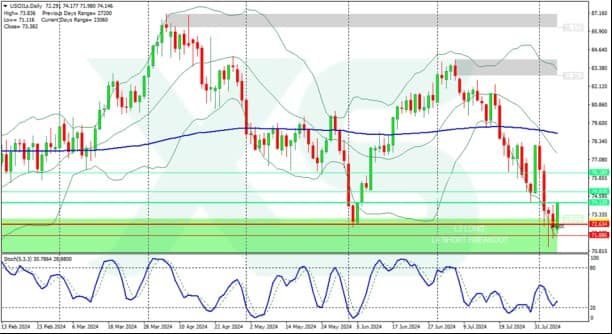Crude oil (WTI) ended a four-day losing streak, trading today, Wednesday, at around $72.50 per barrel.
Oil prices are receiving support from growing concerns about supply shortages and disruptions due to ongoing geopolitical tensions in the Middle East.
Particularly, Hamas announced yesterday, Tuesday, the appointment of Yahya Sinwar as its new leader in Gaza following the assassination of former political bureau chief Ismail Haniyeh.
There are fears of a potential escalation in the region, as Iran and its allies have vowed to retaliate against Israel and the United States for Haniyeh’s death. This might provide some short-term fundamental support for oil prices.
In my opinion, the chances of a rebound in oil prices may be limited due to negative demand sentiment. Chinese trade data has shown that daily crude oil imports in July fell to their lowest level since September 2022, impacting the world’s largest crude oil importer.
The American Petroleum Institute (API) reported a 0.18 million-barrel increase in the weekly crude oil inventory for the week ending August 2, which is less than the expected 0.85 million barrels. This follows a previous decline of 4.495 million barrels.
The U.S. Energy Information Administration is scheduled to release its crude oil inventory report later today, coinciding with estimates of a global oil stock decline of about 400,000 barrels per day in the first half of 2024, with expectations of a drop of about 800,000 barrels per day in the second half of the year. This, in my view, might keep oil prices stable within the range of $85 to $70 in the long and medium term.
Especially since OPEC and other producers, including Russia (OPEC+), are sticking to their plan to gradually end voluntary production cuts starting in October. Even though OPEC’s oil production increased in July, despite the ongoing production cuts by the group, this, in my view, alleviates concerns about potential supply disruptions in the markets.
It is also important to note the movements in the dollar index, which is taking hit after hit. In natural risk-off movements, although the U.S. dollar is considered a haven, and since the same U.S. data triggered risk-off sentiment in the markets, it does not make sense for investors to hold on to the dollar anymore. This naturally directs investments to safe bonds, with expectations that these high returns will end soon after Federal Reserve Chairman Jerome Powell hinted at the possibility of an interest rate cut in September.
The question for this week, in my opinion, is whether the markets are overreacting to this and whether this is an ideal moment to buy on dips across all assets. In my view, yes, the markets have somewhat overreacted because when we look at the prices on the charts, we find them at very healthy correction levels for the recent exaggerated highs.
On the other hand, despite the recent drop in oil prices, Saudi Arabia is convinced that Asia will continue to grow and demand, raising its prices to that region for the first time in three months. Libya has also begun to cut production at the Sharara oil field by at least 50,000 barrels per day to only 210,000 barrels, and with developments, headlines have emerged indicating that the field has stopped production entirely.
Fortex data shows that the amount of oil floating in tankers has decreased by 31% from last week, which might indicate a recent demand recovery in my view. Overall, commodities are following the global sell-off wave, although losses in the commodity sector seem somewhat limited compared to larger losses in stock markets.
Futures data reveals that many hedge funds have liquidated large portions of their crude oil positions, which might mean that a bearish market could be near after the current upward correction. The stock market needs to return to normalcy after recent declines, and I believe this is the final domino for market stability or entering a recession.
Technical analysis of crude oil (WTI) prices
Crude oil prices on the daily chart show the formation of deep red candles since last week, and it seems they will continue in this direction even with current price corrections that might reach $78.25 and $79.00 again.
It is helpful to take a step back and look at the broader picture. There are still many ongoing geopolitical events that could easily reverse the current decline in oil prices due to concerns about potential supply disruptions. Therefore, it’s prudent to approach these movements with caution, considering factors such as summer holidays and increased demand typical of this time of year, which heightens the tension resulting from seeing less oil supply and impacts market reactions in the short term.
Based on this, we can say that there are two scenarios for forecasting the future movement of crude oil from a technical perspective.

Crude Oil – WTI – Prices Chart MT4 –-XS.com
In a bullish scenario, a significant recovery for crude oil prices could be achieved, potentially occurring quickly if the Relative Strength Index (RSI) exits the recent oversold territory. The first resistance level to watch for a potential bounce is the low from July 30 at $74.60. Once that level is breached, the next resistance level to focus on would be $76.30, a pivotal point before testing the 200-day Simple Moving Average (SMA) at $78.25.
In a bearish scenario, we anticipate that this week’s movements might be in their final stages, as the RSI has exited the oversold zone. There is a possibility of returning to test support around $70.00, which is a significant level for the markets. The markets will look for prices to drop below this level to establish a strong demand zone and buy the dip. The pivotal support level, in this case, would be $67.18, as it coincides with the formation of a triple bottom pattern technically since June 2023, providing strong support for price rebounds.
Support levels: $72.05 – $71.60 – $70.00
Resistance levels: $74.60 – $76.30 – $78.25






Leave a Comment